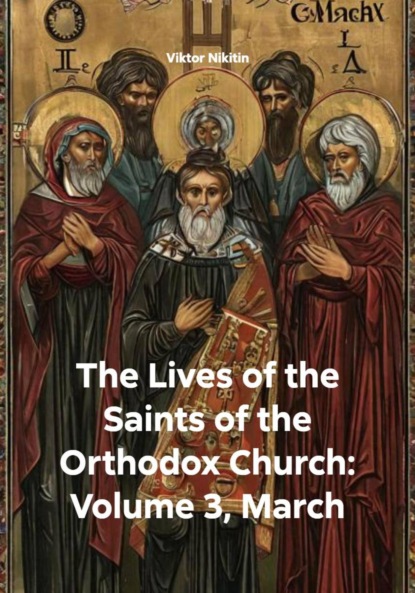
Полная версия:
The Lives of the Saints of the Orthodox Church: Volume 3, March
Saint Virgilius of Arles, Archbishop of Arles (610):
As Archbishop of Arles, Saint Virgilius shepherded one of the most important sees in southern Gaul during a turbulent period. He was known for his care for the poor, his defense of orthodoxy, and his efforts to reform the clergy. His sanctity was widely recognized, and he was revered as a miracle-worker both during his life and after his repose.
Saint Clement, Abbot of Santa Lucia, Syracuse (c. 800):
Saint Clement served as abbot in the monastery of Santa Lucia in Sicily, where he guided monks in strict asceticism and prayer. He was respected for his wisdom, humility, and ability to maintain the monastic discipline during difficult times. His life helped preserve Christian monasticism in Sicily and inspire future generations of monks.
Saints Basil (1249) and Constantine (1257), Princes of Yaroslavl:
These royal saints ruled the principality of Yaroslavl in medieval Russia. Known for their devout Christian lives, they promoted the building of churches and monasteries and were patrons of Orthodox education. Their reigns were marked by justice, charity, and efforts to strengthen the Church, earning them veneration as holy rulers.
Monk-martyr Adrian, Abbot of Poshekhonye (1550), and St. Leonidas (1549):
Saint Adrian was a Russian abbot known for his ascetic life and leadership of the Poshekhonye monastery. Along with his fellow ascetic Leonidas, he endured martyrdom during times of political or religious upheaval, remaining faithful to Christ to the end. Their lives are a testimony to monastic perseverance and sanctity.
New Martyr John the Bulgarian, at Constantinople (1784):
John the Bulgarian was martyred during Ottoman rule in Constantinople, refusing to convert to Islam despite imprisonment and torture. His courage inspired many Christians living under Muslim dominion, and his memory is cherished as a witness to the enduring faith in difficult times.
New Hieromartyr Parthenius, Bishop of Didymoteichon in Thrace (1805):
Bishop Parthenius shepherded his flock faithfully in Ottoman-controlled Thrace. He suffered martyrdom for his faith, refusing to renounce Christianity or submit to pressure from Ottoman authorities. His steadfastness in the face of oppression remains a beacon of pastoral courage.
New Martyr George of Rapsana, at Larissa (1818):
George was a martyr from Larissa who suffered death for maintaining his Christian faith under hostile rule. His sacrifice strengthened the faith of local Christians and is commemorated as an example of endurance.
Saint Nikolai (Velimirovich), Bishop of Ohrid and Zica, Serbia (1956):
One of the most influential Serbian Orthodox bishops and theologians of the 20th century, Saint Nikolai was known for his deep spirituality, theological writings, and pastoral care. He endured imprisonment during both the Nazi occupation and later under the communist regime. His teachings continue to inspire Orthodox Christians worldwide, emphasizing love, repentance, and spiritual renewal.
New Hieromartyrs of the 20th Century:
Nicholas Pokrovsky (1919)
John Mirotvortsiev (1938)
Theophan (Grafov), Hierodeacon of Borisoglebsk Monastery, Vladimir (1938)
Mardarius (Isaev), Hieromonk of Yurievskoe, Yaroslavl (1938)
These martyrs suffered under Soviet persecution of the Orthodox Church. Arrested for their unyielding commitment to Christ and pastoral ministry, they endured torture and execution without renouncing their faith. Their blood is a testament to the survival and resurgence of Orthodoxy in the modern era.
Other Commemorations:
Translation of the relics (1463) of St. Theodore, Prince of Smolensk and Yaroslavl (1299), and his children Saints David (1321) and Constantine (ca. 1322): The moving of these holy relics was celebrated as a sign of God's continued blessing on this royal family, known for their piety and support of the Church.
Repose of Metropolitan Cornelius of Novgorod (1698): Metropolitan Cornelius was a wise and devout shepherd of the Church in Novgorod. His peaceful repose marks the end of a life spent guiding the faithful with compassion and zeal.
* * *
Lives of the Saints Celebrated on March 6
Monk-martyrs Conon and his son Conon of Iconium (270–275)
Saint Conon the Elder was a devout Christian and monk living in Iconium during the reign of Emperor Aurelian, a time marked by fierce persecutions against Christians. His son, also named Conon, followed closely in his father’s footsteps, embracing monasticism and a life of holiness from a young age. When the imperial edicts demanded Christians to renounce their faith, both Conons refused. They were arrested and subjected to harsh tortures intended to force their apostasy. Despite brutal beatings and threats, their courage remained unshaken. The father encouraged his son to stand firm in Christ, and together they bore witness to their faith until they were beheaded. Their martyrdom inspired many in the region, and their story became a testimony to the strength of family faith and the power of steadfastness in trials.
Martyrs Cyriacus and 12 companions, at Augsburg (c. 304)
Saint Cyriacus and his twelve companions were soldiers and citizens of Augsburg during the Diocletian persecution. When the imperial authorities demanded sacrifices to pagan gods, Cyriacus led a group who refused to betray their Christian faith. Arrested and imprisoned, they endured interrogation and torturous punishments without renouncing Christ. Throughout their sufferings, Cyriacus acted as a spiritual leader, encouraging his companions with words of faith and hope. Their steadfastness in the face of death caused many pagans to marvel and eventually led to their execution by the sword. These thirteen martyrs became symbols of unity and courage for early Christians in Germany.
Martyr Euphrosynus, in boiling water
Saint Euphrosynus is remembered for his extraordinary courage in enduring one of the most horrific forms of martyrdom. During a wave of persecution, he was condemned for his unwavering confession of Christ. His torturers threw him into a large cauldron of boiling water, intending to destroy his body and spirit. Miraculously, Euphrosynus remained alive and unharmed for a time, an event that deeply moved witnesses and confirmed the power of God working through him. His martyrdom is a profound example of divine protection and perseverance under suffering, inspiring believers to trust in God's strength amid torment.
Monk-martyr Maximus, by stoning
Saint Maximus was a monk renowned for his humility, meekness, and fervent asceticism. His holiness attracted many followers, but also the enmity of persecutors who sought to silence him. Arrested for his outspoken faith and monastic witness, Maximus faced brutal condemnation. His execution by stoning was a public spectacle designed to intimidate others. Yet Maximus forgave those who stoned him and prayed for their repentance until his last breath. His life and death embody the Christian virtues of patience, forgiveness, and courage in persecution.
The Uncovering of the Precious Cross and the Precious Nails by Empress St. Helena (326)
The discovery of the True Cross is among the most celebrated events in Christian history. Empress Helena, mother of Emperor Constantine the Great, traveled to Jerusalem to locate the site of Christ’s crucifixion. Guided by divine revelation and local testimony, she uncovered three crosses buried near Golgotha. To determine which was the True Cross, a sick woman was healed by touching one of the crosses, confirming its authenticity. Alongside the cross, the nails used in Christ’s crucifixion were also found. These relics were enshrined with great reverence, becoming objects of deep veneration throughout Christendom. Empress Helena’s pilgrimage and discovery strengthened the Christian faith in the empire and established a lasting tradition of honoring the Cross as the symbol of salvation.
Venerable Arcadius, monk of Cyprus (361), and his disciples Julian and Euboulos
Saint Arcadius was a solitary monk on Cyprus whose asceticism and prayerfulness made him a spiritual father to many. He lived during a period of theological turmoil and pagan resurgence, yet he remained steadfast in the ascetic life, devoting himself to contemplation and healing. His disciples Julian and Euboulos, inspired by his example, also became renowned for their holiness. Together, they formed a small but influential monastic community that promoted spiritual renewal on the island, emphasizing humility, fasting, and love. Their lives were marked by numerous miracles, including healings and prophetic gifts, and their memory endures as a model of monastic dedication.
Saint Arkadios, Archbishop of Cyprus
Saint Arkadios served as Archbishop during a time when the Church of Cyprus was consolidating its faith and structure. Known for his wisdom and pastoral zeal, Arkadios defended orthodox doctrine against heresies and schisms. He cared deeply for the welfare of his flock, tirelessly visiting parishes and encouraging the clergy and laity to deepen their spiritual lives. He is also remembered for charitable works and support of monastic communities, fostering a spiritual renaissance in Cyprus. His episcopate strengthened the Church’s unity and resilience amid external pressures.
Venerable Hesychius the Wonderworker
Saint Hesychius was a monk and ascetic famed for his gift of healing and miracles. Through his life of prayer and fasting, he was granted by God the ability to cure illnesses and provide spiritual guidance. Many came to him for relief from both physical and spiritual suffering. Hesychius’s humility was as notable as his miraculous works; he credited all power to God and avoided fame. His life exemplifies the power of asceticism combined with divine grace, making him a beloved figure among the faithful.
The Holy 42 Martyrs of Amorium (in Phrygia), including Passion-bearers Constantine, Aetius, Theophilus, Theodore, Melissenus, Callistus, Basoes, and others, in Samarra (845)
The city of Amorium in Phrygia was a prominent Byzantine stronghold until its fall to Abbasid forces in 838. After the siege, 42 Christian soldiers and citizens were captured and brought to Samarra. Among them were leaders such as Constantine, Aetius, and Theophilus. The captives were pressured to convert to Islam but refused, bravely confessing Christ despite brutal torture and humiliation. They were imprisoned for seven years before being executed for their faith. Their martyrdom became a profound symbol of Christian endurance under Islamic rule and was widely commemorated in the Byzantine world as a testament to courage and unwavering faith.
Saint Marcian of Tortona (120)
Saint Marcian is venerated as the first bishop of Tortona in northern Italy. According to tradition, he was sent from Rome by the apostles or their successors to establish the Church in this region. Marcian evangelized the local people, established Christian communities, and was eventually martyred for his faith during early persecutions. His life laid the groundwork for the Christian presence in the Po Valley, and his memory as a pioneer bishop and martyr has been cherished throughout the centuries.
Saint Patrick of Avernia (c. 307)
Little historical detail survives about Saint Patrick of Avernia, but he is commemorated for his steadfast faith during early persecutions of Christians in Gaul. Martyred around the early 4th century, his witness is honored as one of many who suffered for Christ during the widespread Diocletianic persecution. His life encourages the faithful to remain courageous amid adversity.
Конец ознакомительного фрагмента.
Текст предоставлен ООО «Литрес».
Прочитайте эту книгу целиком, купив полную легальную версию на Литрес.
Безопасно оплатить книгу можно банковской картой Visa, MasterCard, Maestro, со счета мобильного телефона, с платежного терминала, в салоне МТС или Связной, через PayPal, WebMoney, Яндекс.Деньги, QIWI Кошелек, бонусными картами или другим удобным Вам способом.
Вы ознакомились с фрагментом книги.
Для бесплатного чтения открыта только часть текста.
Приобретайте полный текст книги у нашего партнера:
Полная версия книги
Всего 10 форматов



